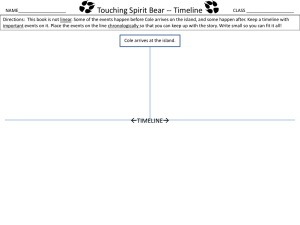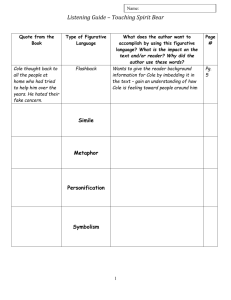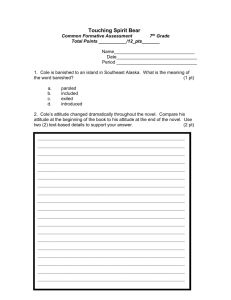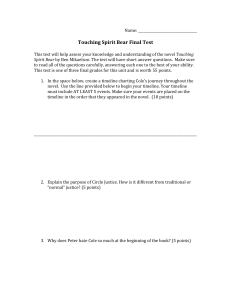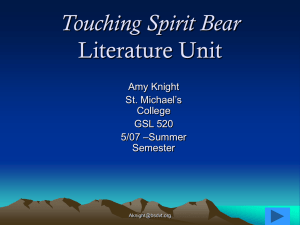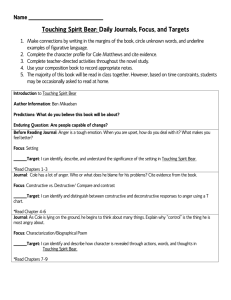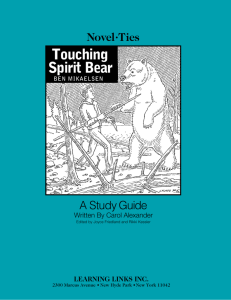Touching Spirit Bear
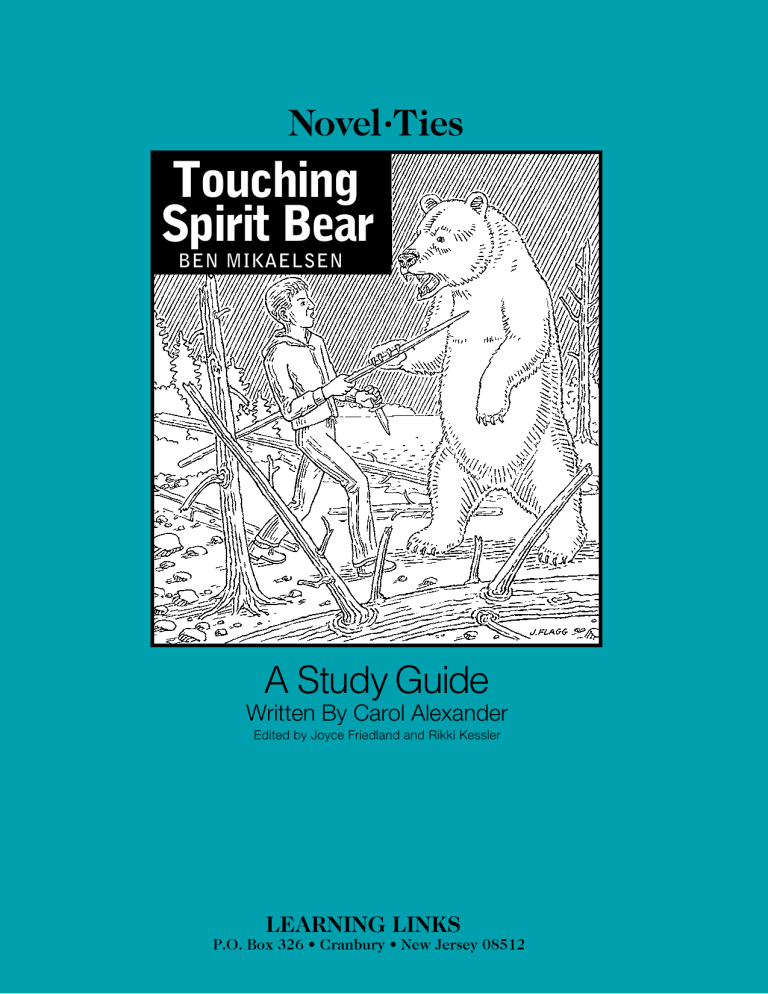
Novel
•
Ties
Touching
Spirit Bear
Ben Mikaelsen
A Study Guide
Written By Carol Alexander
Edited by Joyce Friedland and Rikki Kessler
LEARNING LINKS
P.O. Box 326 • Cranbury • New Jersey 08512
TOUCHING SPIRIT BEAR
TABLE OF CONTENTS
Synopsis . . . . . . . . . . . . . . . . . . . . . . . . . . . . . . . . . . . . . 1
Background Information . . . . . . . . . . . . . . . . . . . . . . . . 2
Pre-Reading Activities . . . . . . . . . . . . . . . . . . . . . . . . . . 3
Chapters 1 - 5 . . . . . . . . . . . . . . . . . . . . . . . . . . . . . . 4 - 7
Chapters 6 - 9 . . . . . . . . . . . . . . . . . . . . . . . . . . . . . 8 - 10
Chapters 10 - 15 . . . . . . . . . . . . . . . . . . . . . . . . . . 11 - 13
Chapters 16 - 20 . . . . . . . . . . . . . . . . . . . . . . . . . . 14 - 15
Chapter 21 - 24 . . . . . . . . . . . . . . . . . . . . . . . . . . . 16 - 17
Chapters 25 - 28 . . . . . . . . . . . . . . . . . . . . . . . . . . 18 - 19
Cloze Activity . . . . . . . . . . . . . . . . . . . . . . . . . . . . . . . . 20
Post-Reading Activities. . . . . . . . . . . . . . . . . . . . . 21 - 22
Suggestions For Further Reading . . . . . . . . . . . . . . . . 23
Answer Key . . . . . . . . . . . . . . . . . . . . . . . . . . . . . . 24 - 25
Novel-Ties ® are printed on recycled paper.
The purchase of this study guide entitles an individual teacher to reproduce pages for use in a classroom. Reproduction for use in an entire school or school system or for commercial use is prohibited. Beyond the classroom use by an individual teacher, reproduction, transmittal or retrieval of this work is prohibited without written permission from the publisher.
Copyright © 2004, 2008 by LEARNING LINKS
TOUCHING SPIRIT BEAR
For the Teacher
This reproducible study guide to use in conjunction with the novel
Touching Spirit Bear consists of lessons for guided reading. Written in chapter-bychapter format, the guide contains a synopsis, pre-reading activities, vocabulary and comprehension exercises, as well as extension activities to be used as follow-up to the novel.
In a homogeneous classroom, whole class instruction with one title is appropriate. In a heterogeneous classroom, reading groups should be formed: each group works on a different novel at its reading level. Depending upon the length of time devoted to reading in the classroom, each novel, with its guide and accompanying lessons, may be completed in three to six weeks.
Begin using NOVEL-TIES for reading development by distributing the novel and a folder to each child. Distribute duplicated pages of the study guide for students to place in their folders. After examining the cover and glancing through the book, students can participate in several pre-reading activities. Vocabulary questions should be considered prior to reading a chapter; all other work should be done after the chapter has been read. Comprehension questions can be answered orally or in writing. The classroom teacher should determine the amount of work to be assigned, always keeping in mind that readers must be nurtured and that the ultimate goal is encouraging students’ love of reading.
The benefits of using NOVEL-TIES are numerous. Students read good literature in the original, rather than in abridged or edited form. The good reading habits, formed by practice in focusing on interpretive comprehension and literary techniques, will be transferred to the books students read independently. Passive readers become active, avid readers.
LEARNING LINKS
TOUCHING SPIRIT BEAR
PRE-READING ACTIVITIES AND DISCUSSION QUESTIONS
1.
Preview the book by reading the title and the author’s name and by looking at the illustration on the cover. What do you think the story will be about? Where and when do you think it takes place?
2.
Social Studies Connection: Read the Background Information on page two of this study guide and do some additional research to learn about the Tlingit Indians.
Brainstorm with a group of classmates to fill in a K-W-L chart, such as the one below.
Jot down what you already know in the first column. List your questions in the second column. When you finish the book, record what you learned in the third column.
What I Know
–K–
What I Want to Learn
–W–
What I Learned
–L–
3.
Social Studies Connection: On a map or globe locate the places on Cole’s route from Minneapolis to Seattle; on to Ketchikan, Alaska; and finally on to the Tlingit village of Drake. About how many miles did Cole have to travel between Minneapolis and his destination? As you read the novel consider how great is the distance, both physically and emotionally, between the beginning and the end of his journey.
4.
With your classmates, discuss books and films in which the main character must survive an ordeal of the body and spirit. Make a list of these books and films, including any details about setting or conflict that you recall. Compare your list with those of your classmates.
5.
Cole Matthews, the main character in this novel, has several important conflicts he must resolve. What kinds of conflicts have you experienced in your own life? With a group of classmates, discuss these conflicts and brainstorm ways in which such problems might be settled.
6.
Find some pictures of the Alaskan wilderness and the animals that inhabit the region. Display these pictures on the classroom bulletin board as you and your classmates read the book.
7.
Do some research to find out how our legal system handles criminal cases involving juvenile offenders. Then answer the following questions:
• What happens in the court system when a young person commits a crime?
• What options does our legal system provide when helping to rehabilitate a youthful offender?
• Which alternatives seem most likely to help a troubled teen live a better life?
8.
The main character in the story has to set some major goals for himself in order to change the direction of his life. What kinds of goals have you set for yourself ? Make a list of three goals that you hope to reach.
LEARNING LINKS 3
TOUCHING SPIRIT BEAR
Chapters 1 – 5 (cont.)
Questions:
1.
Why was Cole Matthews facing an entire year alone in southeast Alaska?
2.
Why wasn’t Cole worried about the terms of his punishment?
3.
Why had Cole attacked Peter Driscal?
4.
In what basic way was Native American Circle Justice different from the standard system of justice?
5.
What did Edwin mean when he warned Cole that he was part of a “much bigger circle” on the island?
6.
Why did Garvey hesitate before becoming Cole’s sponsor?
7.
Why did Cole burn down his shelter?
8.
Why had Garvey asked Cole to taste each ingredient before sampling the cake?
9.
Why were the decisions made at the healing circle important to Cole?
1 0.
Why did Cole return to the island after attempting escape?
Questions for Discussion:
1.
Why do you think Circle Justice was offered to Cole as an alternative to a prison term? Do you think it might be a successful alternative for Cole?
2.
Do you think Cole’s parents were the cause of their son’s violence, or did Cole share responsibility for his behavior?
3.
Why might the island be a good place for a person like Cole to find himself? Can you think of any other place that might serve the same purpose?
4.
Why do you think Garvey agreed to be Cole’s sponsor?
Literary Elements:
I.
Setting —Setting refers to the time and place where the events of a novel occur. What is the setting of Touching Spirit Bear ?
________________________________________________________________________________
How does the setting shape what happens in the novel?
________________________________________________________________________________
________________________________________________________________________________
LEARNING LINKS 5
